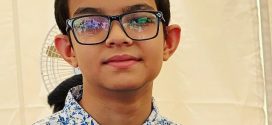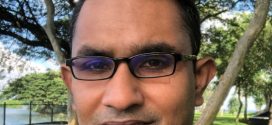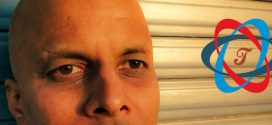Nilay Shah is a young and aspiring author from Ahmedabad, Gujarat, India. Since an early age the stories in his mind kept him intrigued and once the inner call became so irresistible and he settled a little in the life, he decided to pen them down. And thus his first book “Asammat” came into existence. Asammat is a Gujarati novel written with a different kind of perspective. As the book was kind of different than the traditionally published Gujarati books, he was not sure about the response from the readers. But, it was encouraging and thus he decided to pen down the book in English also. A Life To Die For is the English version of the same. But, it is not just the translation. It is kind of a re-telling of the story from a different perspective. Some changes in the story are made, some incidents are added/updated/deleted and then he got it published via Zorba Books.
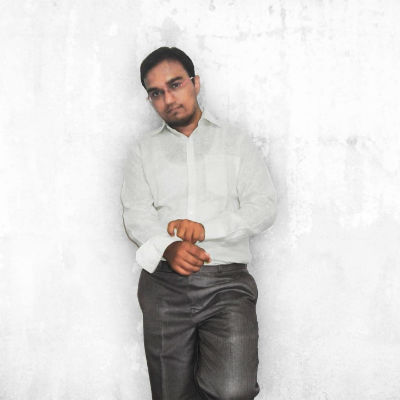
Nilay Shah – author of – A Life To Die For
He is a techno-savvy fellow and you can see carry catcher of the characters of his book and even a short book trailer on his website. The book – A Life To Die For – is good at many literary aspects and it has its own share of ups and downs. You can read detailed book reviews at:
After reading the book and knowing a little about Nilay, we were curious to interact him and fortunately, the things worked out. Here is an interesting Q/A session with Nilay.
Congratulations! Your book – A Life To Die For – is getting good reviews and I am sure you might be getting more and more positive response from the readers. Please share your feelings.
Hi! Thanks, Jiten. Well, undoubtedly, it’s an amazing feeling to have my book out there, read and liked. Of course, it is supposed to take some more time before I get to know a larger picture of response the book generates, but at this moment, I’m patiently, and confidently, waiting for that to come to being.
I am a 24 years old CA from Ahmedabad. Bearing this tag, one is sure to take me for a study-freak. Well, it turns out, I never was. I have loved weaving varied kinds of stories instead, ever since my early childhood, and would have any day preferred that to be my profession over the current one, where I albeit work satisfactorily 8-hours a day. But, being from a middle class family, playing a safe bet was always a pre-condition, you know; and therefore, the usual “What-If” analogy drove me to opt for something that was safer in its prospects, while also allowing me to slowly, but progressively, work towards the dream I have always had.
Passion. As I said, storytelling has always fascinated me, be it in the form of short stories, or plays, or novels, or film making. Even when I am not doing anything, there’s always a story going on inside my head, which I might not even consciously know about at that point of time. So, it wasn’t really a decision that I took to write; it was something that was just supposed to happen.
I can’t really recall a single starting point for Asammat, as there were a lot of factors that contributed to the whole of it. The most influential one was my growing understanding of my disregard of the fact that at every stage, every moment in our life, we have to face disagreements with the outer world, which, at times, leads to disagreement with our own selves. I always used to wonder if there could be anything, at all, that every single individual on this earth can form the same opinion about. This I combined with a law of economics that I had fictionalized and started building blocks of the story that could help me find an answer to the question I had. For the kind of stories I loved, the novel was sure to find complexity in its narration, which ultimately ended up restricting the target audience to a specific age-group. The novel nevertheless fared pretty well as far as the response of the readers was concerned.
Even before I had started off with Asammat, I knew the reader-base for the Gujarati version would be limited, largely because even a large mass of the Gujarati readers belonging to the age-group I am talking about have lately shifted their focus towards the English works. So, if I wanted to maximise the outreach of this story, which I believed it deserved, I had to come out with a version suitable for a larger market. Hence, A Life To Die For.
A Life To Die For draws its inspiration from the real life situation and places, but fictionalises it to such an extent that it ends up belonging to a place unique to its own characteristics. Kashwarg of 2034, in my opinion, is an extreme version of the present day Kashmir. It suffers of issues more turbulent than in the reality, requiring much more drastic measures. Having said that, despite Kashwarg being such a messy and troubled land, it is still not the factor that makes this story volatile as it is. Instead, it is the characters that share their emotions with this land, and their inter-personal feelings that are at the core of the story. Therefore, while the Kashwarg-Kashmir analogy does play a pivotal role in the story, its relevance remains limited only to mirroring outside the chaos played out inside the characters’ psyche. I believe, this calls for even more courage.
See, the biggest challenge one could face while drafting a book so unusual always drives home scepticism. I mean, right from the time I envisioned this story I knew I was on for something more than ordinary, and yet, every few days during the process, I would end up doubting whether the story was going in the right direction or not, whether I was on the right path or not. When you know something is good, you just don’t want to leave any room for imperfection, which ultimately makes you wonder about the perfection of every perfect thing related to it. But, it all just paid off. When it was done, and it was done so much to my satisfaction, I realised it all was just my mind’s play. And yet, that scepticism, that challenge – only helped me do better with every next page; so, yeah, I am happy I actually faced it.
Ever since I published Asammat, even though the publisher for that book was very supportive and amazingly co-operative of a newcomer, I had realised that I was someone who liked to have full creative control over the process of book publishing. Doesn’t the author know the best what her or his book needs? Therefore, I had set my preference since then for self-publishing for A Life To Die For. But the fear of not reaching an audience large enough made me tone down to the traditional route and I did try hunting for publishers for a while. But, impatience grew on me, and I quickly shifted back to my preferred mode. Therefore, I can’t say the journey was easy; but neither do I really know how it would have been had I been patient enough.
A man is seen walking towards a big, like, really big, mask – a layer of his persona he is supposed to walk away from, but he simply won’t be able to; and therefore, it eventually becomes his identity. Now, this identity of his is on fire and one part of him, the right side – the more transparent one, pulls him back; while the left one – the darker one, pushes him afar. The maps carved out on the mask by the fire hint at both the – sides, times and geographies – in the story each of the characters goes through. And the last: the man is seen pulling a sledge, the whole scene appearing as if from the reader’s POV – the man is taking us on a journey of internal conflicts, which are reflected outside in the form of inter-personal and societal conflicts.
Except for the raw photograph used, which was clicked by my sister, Chirali, I designed the whole of it.
I felt characters in the story were a good enough idea to rouse curiosity among the prospective readers. So, one day, I just casually asked my friend, Prashant, who is a fantastic artist, if he could spare some time for me and draw a few of such carry catchers for marketing of my book. I gave him basic outline of how they could be, and within merely twelve hours, bam, he was done with it. All I had to do was just to photoshop them a bit. I must say, they are, by far, my most favourite marketing material for this book I have, after the book trailer.
I would just say one thing: it is not the kind of a story you get to have in your hands often. What aspects are good and what are not is for the readers to judge, but it is something unusual, that I can say for sure.
Frankly, it is difficult to choose a few. There are just a lot of such portions in the book, while writing which, I was telling myself, “Great job, Nilay.” For instance, when both the stories – of Asrabad and Kashwarg – converge in the eighth chapter, or when Alvira’s secrets are revealed, or when the valley of Kashwarg sees a breakdown – all such dramatic scenes I have enjoyed narrating like hell. But the one that stands out is the whole of the act in Zero Past End, where all the characters and stories finally head towards one single destination and the story blasts to the highest pitch. I mean, in mystery genre, the final act is always the most interesting, but here, the difference is, how it really happens. My fingers have never moved as swiftly on the keyboard as they had while working on that chapter.
Hah, that’s kind of a dream and my answer would also be of those sorts only. As for Atmaj or The Enforcer of Anger, the kind of intensity and depth are required, I think Rajkumar Rao, or Vicky Kaushal, can be a perfect match. The breathtaking beauty and mysteries of Alvira can be reflected well by Aditi Rao Hydari. And, Hrithik Roshan for the super impressive physical and mental strength of Adil. For other two major characters of Aryaman and Preksha (or Anusha), I would prefer new, unknown faces.
It would seem exaggerated to others if I say it has completely changed me, but that’s the truth. The very idea of this story had come from my own experiences and ideologies, as once, I used to believe that pain and suffering, anger and hatred contribute to more of a human being than any positive counterpart of theirs.
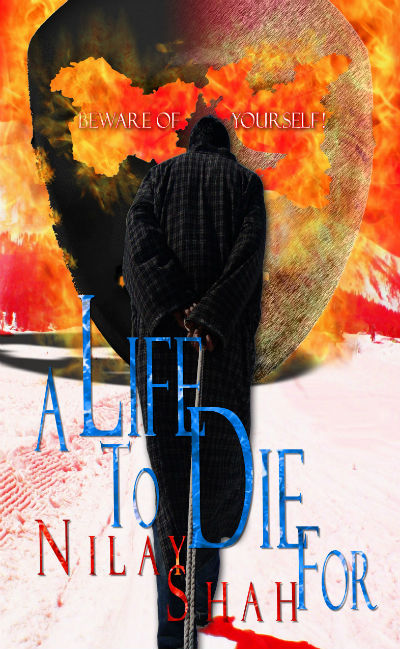
A Life To Die For by Nilay Shah – Book Cover
This is exactly what the characters of A Life To Die For hold up as well, in one way or other. That is why, as the story progressed, I, along with them, dived deeper into our own psyches to realise what really lies in there. By the time the story ended, there was a whole new dimension to this theory that I had built for myself, which was probably the answer to all the conceptions I earlier had.
Whenever a story is on the board, I am so excited that I just try stealing some time out for opening my laptop and resuming writing as and when I got a chance. So, I don’t really like to follow any pattern.
Thrillers, even better when with a top-up of mystery.
George Orwell‘s 1984 and Animal Farm, Dhruv Bhatt‘s Akoopar (Gujarati), Ashwin Sanghi‘s The Rozabal Line, Dan Brown‘s Deception Point, Paulo Coehlo‘s The Alchemist and Robin Sharma‘s The Monk Who Sold His Ferrari.
I think George Orwell and Ashwin Sanghi are the authors whose works I have enjoyed the most so far.
Currently, I am halfway through, once again – Ashwin Sanghi‘s – Chanakya’s Chant.
I think all of the people I have come to know of or I have loved, have had some or other stake in building of what I am right now. This includes from a watchman, who has always given a warm smile whenever he saw me, to my family, who has been my backbone and is the best of all I have seen. What you would find funny is, the positives of any person I meet inspire me to be a better person, and the negatives, become inspirations for my characters.
Movies – both watching and making; music; reading and travelling. All these combined could be put next to Oxygen in terms of importance.
What could be better than every single person getting a chance to bring their works out and make them known? The sheer possibility and ease of going public with ideas inspire the aspiring writers to actually put those ideas on paper. What is good, survives; and what is not, doesn’t. But, at least, the market has developed a good appetite to accommodate all of these. A remarkably rapid growth of online retailers like Amazon and Flipkart, along with rise in the demand of eBooks has pushed the idea of self-publishing further; and all of these three together contribute to a whole new, better, scenario for readers, books and authors. Of course, this can’t outweigh the importance of traditional publishing, offline bookstores and physical books, but shall only be supplement to these.
Like most people out there, I also believe social networks these days have invaded our houses and lives to a painfully high extent. But at the same time, this is also the reason why they play a very important role in maintaining societal order and raising awareness. Social networks are preferred over news channels, newspapers or any other medium that transmits information. Be it Facebook or Twitter or Instagram or any other one, they all are as useful in spreading awareness as they are dangerous in spreading panic or, say, rumours. Therefore, in my opinion, with proper regulatory intervention and co-ordination between the regulator and the social networks, if transmission of information through social networks is controlled, nothing can be more relevant than these to make people aware of the causes.
Three out of five people I meet ask me if my book is available on Kindle or not. Sums it up, doesn’t it?
Honestly, I don’t seem to find this tradition followed anywhere around me at present either. If kids are to be kept occupied or put to sleep with the help of mobile games and videos, when shall they have the opportunity to be told these stories?
- Web: http://www.nilayshah.net/
- Twitter: @AuthorNilay
- Facebook: https://www.facebook.com/AuthorNilay/
- Instagram: AuthorNilay
- Email: mail@nilayshah.net
It is an intense psychological drama with the backdrop of a love story, set in the alternative fourteenth century. Based on one of my short stories, the tale is about an artist who loves a woman who never existed and lives only in his head, and how he fights with himself to gain dominance in her eyes.
A sample chapter is available for free at author’s website. Here is the quick link to the same:
http://www.nilayshah.net/a-life-to-die-for-sample-chapter/
Buy Book From Amazon India – Paperback Edition
Buy Book From Amazon India – Kindle Edition
Buy Book From Amazon US – Paperback Edition
Buy Book From Amazon US – Kindle Edition
Over To You:
Hope you have enjoyed the Q/A session with him. And many of your questions might be already answered. Let us know that what do you think about this Interview session? Do you want us to ask anything else to him on your behalf? Do let us know. Also, let us know which other authors you like us to interview? Do let us know your thoughts and remarks via comments below. Do not forget to share this article with your friends over various social networks via Twitter, Facebook, Google Plus and others. And yes, you may like to subscribe to our RSS feeds and follow us on various Social networks to get latest updates for the site to land right in your mail box.
 ThinkerViews – Views And Reviews Personal views and reviews for books, magazines, tv serials, movies, websites, technical stuff and more.
ThinkerViews – Views And Reviews Personal views and reviews for books, magazines, tv serials, movies, websites, technical stuff and more.

